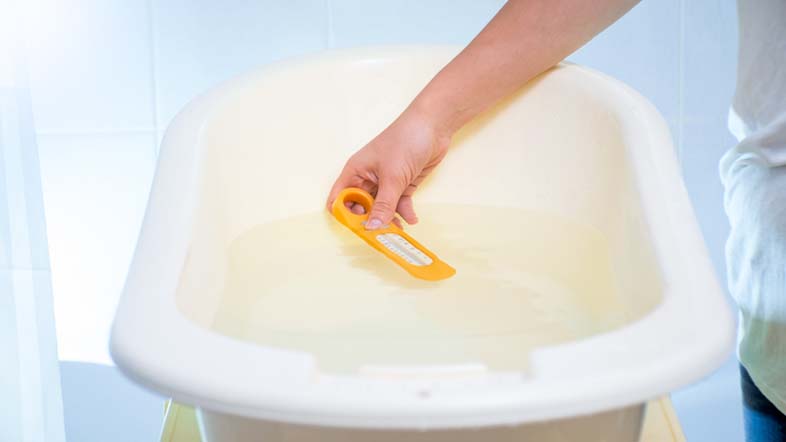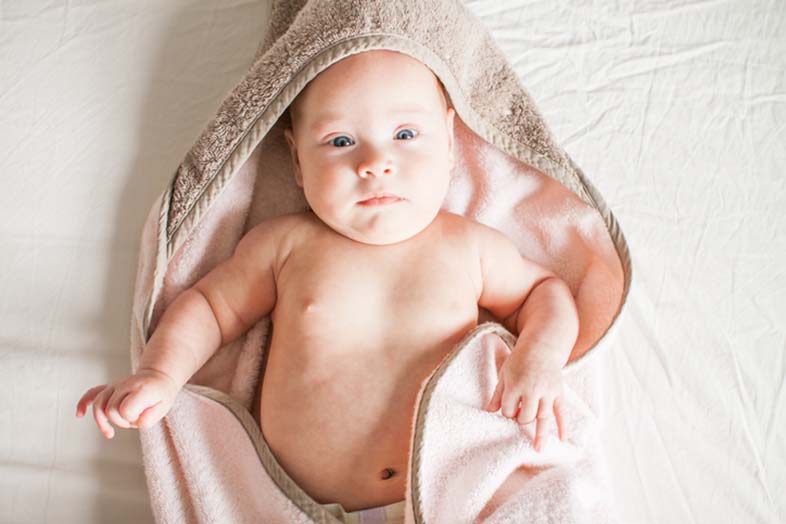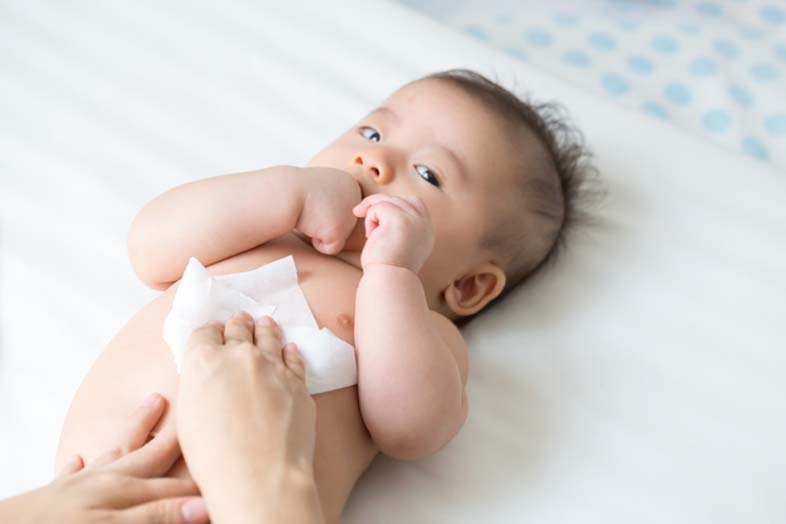In this feature we will tell you:
- When is the right time for your baby’s first bath?
- And when is the best time for a baby’s bath?
- What do you need to bath your baby?
- How to bathe a newborn safely
- Safety tips
- How often should I bath my newborn?
- How to top and tail your baby: washing between baths
- What to use
When is the right time for your baby’s first bath?
In the past, babies would be bathed very soon after birth and midwives would often use this as an opportunity to teach mums how to bathe a newborn,” says Kate Mundell of Naytal.
“However, we now realise that babies do not need bathing immediately after birth, as your little one is born covered with a substance called vernix that protects their skin. This is a magic coating your baby has formed inside the womb that stops baby skin from becoming too dry.
When your little one is born, they will be rubbed gently by your birth team with a soft towel to remove blood and given straight to you for some skin-to-skin bonding.”
You may want to wait until your baby’s umbilical cord has fallen off (about a week after birth) before giving your baby a proper bath. Instead, use the Top and Tail procedure in the meantime.
When is the best time of day for a baby’s bath?
Once you have recovered from the birth and are getting used to handling your baby, you can add a bath into your baby’s routine, at bedtime or another time of the day if you prefer.
Kate says: “A warm bath can help calm your little one, soothe an achy tummy if they have wind or colic and get them nice and sleepy and ready for bed.”
Gradually, you’ll notice your baby has times of the day when they are more likely to sleep. In the early weeks, it pays to go with this natural routine and as your baby gets older, you and they can start to get into a more ‘normal’ routine, with daytime naps and a longer nighttime sleep from about 7pm.
“Ultimately, you can bath your baby at a time that suits you both. They need to be awake, so don’t wake your baby up for a bath. They should also be comfortable, not hungry and in a good mood, so if your baby is hungry, grumpy or unsettled, leave it for another time,” says Kate.
“Bath time can be very exciting for your baby, especially if they like the warm water and the time you spend together, so it can leave them nice and sleepy and it may help your baby get to sleep and stay asleep a little longer.”
What do you need to bath your baby?
Gather all the things you need for a bath before you even get your baby from their crib. You will need:
-
Towels (look for a baby towel with a hood to keep their head warm)
-
A set of clean clothes
-
A fresh nappy and wipes
-
A baby bath (you can also use a sink or your own bath)
-
A bath support if you’re using one
-
Bath thermometer
-
A soft flannel
-
A plastic cup for rinsing your baby (optional)
-
Toiletries suitable for babies (a body wash and shampoo, or an all-over product)
-
Moisturiser and barrier cream for after the bath

Step-by-step: How to bathe a newborn safely

Step One: prepare the bath
Fill the bath with warm water and check the temperature with your elbow – never your hand. The ideal baby bath temperature is around 37 degrees Celsius. It should feel warm, but not hot. Stir the water to remove any hot or cold spots.

Step Two: undress your baby
Next, undress your baby down to the nappy and wrap them in a warm towel.

Step Three: clean your baby
Clean your baby’s face first using the Top and Tail technique, remove the nappy, clean this area if it’s dirty and then slowly lower your little one into the water.
Step Four: find the right grip
Keep a firm grip with your less dominant hand (hold with your left hand if you are right-handed) and use the other to wash your baby. “Many mums find the best position is to place your hand under baby’s head and shoulders, holding the arm furthest away from you,” says Kate.
Always keep your hand holding the baby while washing or picking up flannel, shampoo etc.
Step Five: wash your baby
Wash gently from their neck and shoulders, down across their body, reaching under the armpits, into all creases and around the bottom area.
Kate says” “Always clean the face and hair first, then get the hair as dry as possible after cleaning, then wash the rest of the baby. They lose so much heat from their heads when they're wet, so if you do the headfirst and then the body, they should maintain their body temperature a bit better.”
Top tip: keep them warm
A warm flannel over your baby’s chest will help them stay cosy – keep it wet by splashing water from the bath over it frequently.
Important safety tip
When bathing a baby, NEVER leave him or her unattended, not even for a second, as a baby can drown in just a few centimetres of water. Never leave them on a raised bath or changing mat either, as a fall from a high place can cause serious injuries.
How often should I bath my newborn?
It’s not necessary to bath your baby every day – two to three times per week should be plenty, as long as you wash their head and bottom in between, as needed.
How to top and tail your baby: washing between baths
To “Top and Tail” means cleaning your baby’s top (the head and face) and their tail (their bottom area). To do this, you use either cotton wool and warm water or wipes suitable for newborns such as Huggies® Extra Care Sensitive wipes.
-
Take two clean bowls (or a Top & Tail Bowl which has two compartments) and fill them with warm, not hot water.
-
Take a clean piece of cotton wool and using the water from one bowl, clean each eye, starting from the inside corner and moving to the outer corner. Repeat this with a clean piece of cotton wool for the other eye, then for the mouth and nose, the rest of the face, plus those creases in the neck where milk and dribble can get caught.
-
The second bowl is for the nappy area. Kate says: “Make sure you work from the front to the back to avoid bladder infections from bacteria from their anus (bottom). When wiping you should take particular care with girls.”
-
Put a clean nappy on afterwards. Cover the parts of your baby you’re not working on with a warm towel, so they don’t get cold.
Bathing with your baby: co-bathing tips
One lovely way to enjoy some skin-to-skin with your little one is to share bath-time. Co-bathing has plenty of benefits, not least a relaxing routine for you both. Indeed, if you have had a Caesarean, have backache from lifting your baby or are a little nervous of bathing your baby, having a bath with your little one can be the ideal solution.
Make sure the bathroom is warm, have some warm towels ready and get into the bath (sit on a small towel to prevent yourself from slipping) while your partner holds your baby. Next, your partner can undress your baby, then pass him or her to you.
It’s best to have your knees raised, then place your baby on your thighs facing you, with their head raised above the water, their bottom sat in your lap. That way you can chat and interact with your baby while you both enjoy the water.
“If you don’t have anyone with you, have your baby in a bouncy chair next to the bath and only lift them into the bath once you are sitting down in it. Always err on the side of caution,” says Kate.
Baby bath, sink or bucket?
All of the above! You can bathe your little one in a baby bath, in your main bath using a bath support, or even in a sink or basin. Just make sure that if the hot tap is near them, you cover it with a flannel to avoid scalds. Never add hot water directly into the bath while your baby is in the water.
What to use to wash your baby
For newborns, you don’t really need to use soap, bath products or baby shampoo - plain water is ideal. When your baby is a little older, choose a mild baby bath wash and shampoo (look for organic and natural products).
After bath care
Pat your baby’s skin dry, then apply a baby-friendly lotion or oil if needed, plus a barrier cream on the nappy area to prevent nappy rash.
For every step of your parenting journey
We know that the early days of parenthood can be daunting. But Huggies® are here to hold your hand through all the ‘firsts’ - like the first top and tail, changing that first nappy, cutting baby’s nails for the first time and even baby’s first swim.

 your parenting partner
your parenting partner